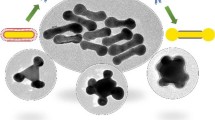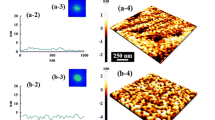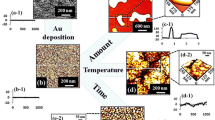Abstract
Surface ligands play critical roles in nano-synthesis and thus it is of great importance in expanding the scope of suitable ligands. In this work, we explore phenynyl ligands in modulating the Au-Au interface when growing Au domains on Au seeds. A patchy growth mode is observed where the emerging islands are flat-laying with holes and branches. This growth mode is distinctively different from the conventional facet-controlled growth using weak ligands, and the non-wetting island growth using strong ligands. Through manipulating the molecular structure and the packing of the phenynyl ligands on the Au seeds, the overgrown Au domains are continuously tuned, from patches to islands, extending the plasmon absorption peak into the near-infrared spectral range. We believe that the new ligand with intermediate affinity and the unusual growth mode would expand the control in both synthesis and application.

摘要
表面配体在纳米合成中起着关键作用, 扩大适用于纳米合成的配体范围具有重要意义. 本工作中, 我们系统研究了炔基配体在金种子上生长金时对金-金界面的调节作用. 我们观察到了一种新的“补丁”生 长模式: 具有孔洞以及分支的金补丁“平躺”在金种子表面. 这种生长模式与传统的弱配体控制的晶面生长以及强配体调控下的非润湿岛状生长截然不同. 通过控制炔基配体的分子结构及其在金种子表面的排列, 生长的金可以从补丁形状连续调节到岛状, 同时其等离子体共振吸收从可见光区扩展到了近红外光谱区域. 我们相信这类具有中等强度、 能够控制特殊生长模式的新配体的应用, 能够显著提升纳米合成及应用中的配体控制作用.
Similar content being viewed by others
References
Boles MA, Ling D, Hyeon T, et al. The surface science of nanocrystals. Nat Mater, 2016, 15: 141–153
Zhu H, Prince E, Narayanan P, et al. Colloidal stability of nanoparticles stabilized with mixed ligands in solvents with varying polarity. Chem Commun, 2020, 56: 8131–8134
Kang H, Buchman JT, Rodriguez RS, et al. Stabilization of silver and gold nanoparticles: preservation and improvement of plasmonic functionalities. Chem Rev, 2019, 119: 664–699
Zhan N, Palui G, Safi M, et al. Multidentate zwitterionic ligands provide compact and highly biocompatible quantum dots. J Am Chem Soc, 2013, 135: 13786–13795
Na HB, Palui G, Rosenberg JT, et al. Multidentate catechol-based polyethylene glycol oligomers provide enhanced stability and bio-compatibility to iron oxide nanoparticles. ACS Nano, 2012, 6: 389–399
Xue T, Lin Z, Chiu CY, et al. Molecular ligand modulation of palladium nanocatalysts for highly efficient and robust heterogeneous oxidation of cyclohexenone to phenol. Sci Adv, 2017, 3: e1600615
Ogiwara N, Kobayashi H, Inukai M, et al. Ligand-functionalization-controlled activity of metal-organic framework-encapsulated Pt nano-catalyst toward activation of water. Nano Lett, 2020, 20: 426–432
Martínez-Prieto LM, Ferry A, Rakers L, et al. Long-chain NHC-stabi-lized RuNPs as versatile catalysts for one-pot oxidation/hydrogenation reactions. Chem Commun, 2016, 52: 4768–4771
Kabiraz MK, Kim J, Lee WJ, et al. Ligand effect of shape-controlled β-palladium hydride nanocrystals on liquid-fuel oxidation reactions. Chem Mater, 2019, 31: 5663–5673
Levi-Belenkova T, Govorov AO, Markovich G. Orientation-sensitive peptide-induced plasmonic circular dichroism in silver nanocubes. J Phys Chem C, 2016, 120: 12751–12756
Han B, Zhu Z, Li Z, et al. Conformation modulated optical activity enhancement in chiral cysteine and Au nanorod assemblies. J Am Chem Soc, 2014, 136: 16104–16107
Li Y, Cheng J, Li J, et al. Tunable chiroptical properties from the plasmonic band to metal-ligand charge transfer band of cysteine-cap-ped molybdenum oxide nanoparticles. Angew Chem Int Ed, 2018, 57: 10236–10240
Lee S, Sim K, Moon SY, et al. Controlled assembly of plasmonic na-noparticles: From static to dynamic nanostructures. Adv Mater, 2021, 33: 2007668
Giansante C. Enhancing light absorption by colloidal metal chalco-genide quantum dots via chalcogenol(ate) surface ligands. Nanoscale, 2019, 11: 9478–9487
Giansante C. Library design of ligands at the surface of colloidal na-nocrystals. Acc Chem Res, 2020, 53: 1458–1467
Kroupa DM, Vörös M, Brawand NP, et al. Tuning colloidal quantum dot band edge positions through solution-phase surface chemistry modification. Nat Commun, 2017, 8: 15257
Huang Z, Zhao ZJ, Zhang Q, et al. A welding phenomenon of dissimilar nanoparticles in dispersion. Nat Commun, 2019, 10: 219
Wang Z, He B, Xu G, et al. Transformable masks for colloidal nano-synthesis. Nat Commun, 2018, 9: 563
Wang F, Cheng S, Bao Z, et al. Anisotropic overgrowth of metal het-erostructures induced by a site-selective silica coating. Angew Chem Int Ed, 2013, 52: 10344–10348
Heuer-Jungemann A, Feliu N, Bakaimi I, et al. The role of ligands in the chemical synthesis and applications of inorganic nanoparticles. Chem Rev, 2019, 119: 4819–4880
Kim D, Lee DC. Surface ligands as permeation barrier in the growth and assembly of anisotropic semiconductor nanocrystals. J Phys Chem Lett, 2020, 11: 2647–2657
Yang TH, Shi Y, Janssen A, et al. Surface capping agents and their roles in shape-controlled synthesis of colloidal metal nanocrystals. Angew Chem Int Ed, 2020, 59: 15378–15401
Zhang Q, Li N, Goebl J, et al. A systematic study of the synthesis of silver nanoplates: Is citrate a “magic” reagent? J Am Chem Soc, 2011, 133: 18931–18939
Sau TK, Murphy CJ. Room temperature, high-yield synthesis of multiple shapes of gold nanoparticles in aqueous solution. J Am Chem Soc, 2004, 126: 8648–8649
Koczkur KM, Mourdikoudis S, Polavarapu L, et al. Poly-vinylpyrrolidone (PVP) in nanoparticle synthesis. Dalton Trans, 2015, 44: 17883–17905
Xia X, Zeng J, Zhang Q, et al. Recent developments in shape-controlled synthesis of silver nanocrystals. J Phys Chem C, 2012, 116: 21647–21656
Wang Y, He J, Liu C, et al. Thermodynamics versus kinetics in nano-synthesis. Angew Chem Int Ed, 2015, 54: 2022–2051
Feng Y, He J, Wang H, et al. An unconventional role of ligand in continuously tuning of metal-metal interfacial strain. J Am Chem Soc, 2012, 134: 2004–2007
He J, Wang Y, Feng Y, et al. Forest of gold nanowires: A new type of nanocrystal growth. ACS Nano, 2013, 7: 2733–2740
Wang Y, He J, Yu S, et al. Effect of thiolated ligands in Au nanowire synthesis. Small, 2017, 13: 1702121
Feng Y, Wang Y, He J, et al. Achieving site-specificity in multistep colloidal synthesis. J Am Chem Soc, 2015, 137: 7624–7627
Jia J, Liu G, Xu W, et al. Fine-tuning the homometallic interface of Au-on-Au nanorods and their photothermal therapy in the NIR-II window. Angew Chem Int Ed, 2020, 59: 14443–14448
Tian X, Zong J, Zhou Y, et al. Designing caps for colloidal Au nano-particles. Chem Sci, 2021, 12: 3644–3650
Xiang T, Zong J, Xu W, et al. Probing the ligand exchange kinetics of phenynyl-based ligands on colloidal Au nanoparticles. Mater Chem Front, 2021, 5: 465–471
Huang J, Liu C, Zhu Y, et al. Harnessing structural darkness in the visible and infrared wavelengths for a new source of light. Nat Nano-tech, 2015, 11: 60–66
Huang J, Zhu Y, Liu C, et al. Unravelling thiol’s role in directing asymmetric growth of Au nanorod-Au nanoparticle dimers. Nano Lett, 2016, 16: 617–623
Feng J, Xu D, Yang F, et al. Surface engineering and controlled ripening for seed-mediated growth of Au islands on Au nanocrystals. Angew Chem Int Ed, 2021, 60: 16958–16964
Choueiri RM, Galati E, Thérien-Aubin H, et al. Surface patterning of nanoparticles with polymer patches. Nature, 2016, 538: 79–83
Zhou L, Qiu X, Lyu Z, et al. Pd-Au asymmetric nanopyramids: Lateral vs. vertical growth of Au on Pd decahedral seeds. Chem Mater, 2021, 33: 5391–5400
Love JC, Estroff LA, Kriebel JK, et al. Self-assembled monolayers of thiolates on metals as a form of nanotechnology. Chem Rev, 2005, 105: 1103–1170
Wang G, Liu Y, Gao C, et al. Island growth in the seed-mediated overgrowth of monometallic colloidal nanostructures. Chem, 2017, 3: 678–690
Zhou J, Jiang Y, Hou S, et al. Compact plasmonic blackbody for cancer theranosis in the near-infrared II window. ACS Nano, 2018, 12: 2643–2651
Dhiman M, Maity A, Das A, et al. Plasmonic colloidosomes of black gold for solar energy harvesting and hotspots directed catalysis for CO2 to fuel conversion. Chem Sci, 2019, 10: 6594–6603
Patterson ML, Weaver MJ. Surface-enhanced Raman spectroscopy as a probe of adsorbate-surface bonding: Simple alkenes and alkynes adsorbed at gold electrodes. J Phys Chem, 1985, 89: 5046–5051
Tang Q, Jiang D. Insights into the PhC≡C/Au interface. J Phys Chem C, 2015, 119: 10804–10810
Chen W, Zuckerman NB, Kang X, et al. Alkyne-protected ruthenium nanoparticles. J Phys Chem C, 2010, 114: 18146–18152
Maity P, Tsunoyama H, Yamauchi M, et al. Organogold clusters protected by phenylacetylene. J Am Chem Soc, 2011, 133: 20123–20125
Laurentius L, Stoyanov SR, Gusarov S, et al. Diazonium-derived aryl films on gold nanoparticles: evidence for a carbon-gold covalent bond. ACS Nano, 2011, 5: 4219–4227
Sun F, Tang Q. First-principles exploration of the versatile configurations at an alkynyl-protected coinage metal(111) interface. Nanoscale, 2021, 13: 819–831
Inkpen MS, Liu ZF, Li H, et al. Non-chemisorbed gold-sulfur binding prevails in self-assembled monolayers. Nat Chem, 2019, 11: 351–358
Schlenoff JB, Li M, Ly H. Stability and self-exchange in alkanethiol monolayers. J Am Chem Soc, 1995, 117: 12528–12536
Feng Y, Wang Y, Wang H, et al. Engineering “hot” nanoparticles for surface-enhanced Raman scattering by embedding reporter molecules in metal layers. Small, 2012, 8: 246–251
Shen W, Lin X, Jiang C, et al. Reliable quantitative SERS analysis facilitated by core-shell nanoparticles with embedded internal standards. Angew Chem, 2015, 127: 7416–7420
Feng Y, Wang Y, Song X, et al. Depletion sphere: Explaining the number of Ag islands on Au nanoparticles. Chem Sci, 2017, 8: 430–436
Durović MD, Bugarčić ZD, Heinemann FW, et al. Substitution versus redox reactions of gold(III) complexes with L-cysteine, L-methionine and glutathione. Dalton Trans, 2014, 43: 3911–3921
Acknowledgements
This work was supported by the National Natural Science Foundation of China (21673117 and 91956109), Jiangsu Provincial Foundation for Specially-Appointed Professor, Jiangsu Science and Technology Plan (BK20211258), Nanjing Tech University (39837102 and 39837140), and SICAM Fellowship from Jiangsu National Synergetic Innovation Center for Advanced Materials.
Author information
Authors and Affiliations
Contributions
Author contributions Zong J, Feng Y, and Chen H conceived the idea and explained the mechanism of structure synthesis, wrote and revised the manuscript. Zong J performed the syntheses and characterization of the nanomaterials. Ren Q, Tian X, and Xiang T participated in the discussion, gave suggestions on the mechanisms, and helped in the artworks.
Corresponding authors
Ethics declarations
Conflict of interest The authors declare that they have no conflict of interest.
Additional information
Supplementary information Supporting data are available in the online version of the paper.
Jianpeng Zong is now a PhD student at the School of Chemistry and Molecular Engineering, Nanjing Tech University, under the supervision of Profs. Yuhua Feng and Hongyu Chen. His research focuses on the synthesis of Janus nanostructures based on interfacial energy control.
Yuhua Feng received his BSc and MSc degrees from Northeast Normal University and PhD degree from Nankai University in 2008. He joined Nanjing Tech University in 2017 as professor. His research interest focuses on the design and synthesis of hybrid nanostructures and their applications in plasmonic, SERS and catalysis.
Hongyu Chen received his BSc degree from the University of Science and Technology of China in 1998 and PhD degree from Yale University in 2004. He joined Nanyang Technological University in 2006 and became associate professor in 2011. He joined Nanjing Tech University as professor in 2016 and now he is a full professor at Westlake University. His research interest focuses on the development of new synthetic control of complex nanostructures.
Supplemental Information
Rights and permissions
About this article
Cite this article
Zong, J., Ren, Q., Tian, X. et al. The patchy growth mode: Modulation of the Au-Au interface via phenynyl ligands. Sci. China Mater. 65, 1687–1695 (2022). https://doi.org/10.1007/s40843-021-1942-6
Received:
Accepted:
Published:
Issue Date:
DOI: https://doi.org/10.1007/s40843-021-1942-6




